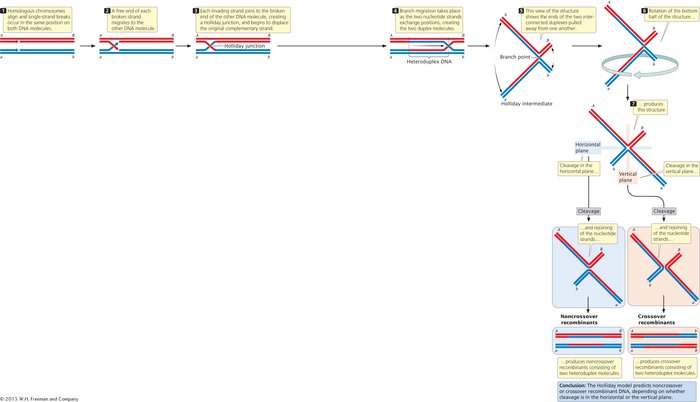9.5 Recombination Takes Place Through the Alignment, Breakage, and Repair of DNA Strands
Recombination is the exchange of genetic information between DNA molecules; when the exchange is between homologous DNA molecules, it is called homologous recombination. This process takes place in crossing over (discussed in Chapters 2 and 5), in which homologous regions of chromosomes are exchanged (see Figure 5.5) and alleles are shuffled into new combinations. Recombination is an extremely important genetic process because it increases genetic variation. Rates of recombination provide important information about linkage relations among genes, which is used to create genetic maps (see Figures 5.12 and 5.13). Recombination is also essential for some types of DNA repair (as we will see in Chapter 13).
Homologous recombination is a remarkable process: a nucleotide strand of one chromosome aligns precisely with a nucleotide strand of the homologous chromosome, breaks arise in corresponding regions of the two DNA molecules, parts of the molecules precisely change place, and then the pieces are correctly joined. In this complicated series of events, no genetic information is lost or gained. Although the precise molecular mechanism of homologous recombination is still not completely understood, the exchange is probably accomplished through the pairing of complementary bases. A single-
In meiosis, homologous recombination (crossing over) could theoretically take place before, during, or after DNA synthesis. Cytological, biochemical, and genetic evidence indicates that it takes place in prophase I of meiosis, whereas DNA replication takes place earlier, in interphase. Thus, crossing over must entail the breaking and rejoining of chromatids when homologous chromosomes are at the four-
Homologous recombination can take place through several different pathways. One pathway is initiated by a single-
251

The exchange of nucleotide strands and branch migration produce a structure termed the Holliday intermediate, which can be cleaved in one of two ways. Cleavage in the horizontal plane, followed by rejoining of the strands, produces noncrossover recombinants, in which the genes on either end of the molecules are identical with those originally present (gene A with gene B, and gene a with gene b). Cleavage in the vertical plane, followed by rejoining, produces crossover recombinants, in which the genes on either end of the molecules are different from those originally present (gene A with gene b, and gene a with gene B). View Animation 9.5 to see how the Holliday model is resolved.
CONCEPTS
Homologous recombination requires the formation of heteroduplex DNA consisting of one nucleotide strand from each of two homologous chromosomes. In the Holliday model, homologous recombination is accomplished through a single-
 CONCEPT CHECK 8
CONCEPT CHECK 8
Why is recombination important?
Recombination is important for generating genetic variation.